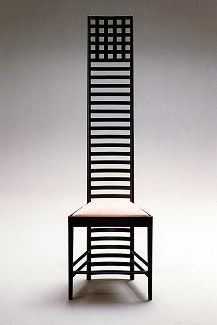(1868-1928)
Scottish architect, furniture designer and painter
At the peak of the Arts & Crafts Movement in Scotland or England, Charles Rennie Mackintosh was the founder of the "Glasgow School", an outstanding architecture and decoration style, forerunner of Modern Movement in Scotland.
In 1884 he trained as an architect in a local firm and studied art and design at evening classes at the Glasgow School of Art, in Scotland. In 1890, he established his own practice and in 1894 he founded a group called "The Four" with fellow artists he met at art school. Influenced by Continental Art Nouveau, Japanese art, Symbolism and new-Gothic styles, they successfully exhibited metalwork, furniture and illustrations in Glasgow, London, Vienna and Turin. The majority of Mackintosh's works and innovative designs were created within a short period of intense activity between 1890 and 1911.
He collaborated to the 1900 Vienna Secession and with Austrian architect-designer J. Hoffmann, greatly influencing his work. In 1902, he presented his "Mackintosh" room furniture at the Turin International Exhibition and he later designed houses and various Tea-Rooms interior decorations. Very appreciated all over Europe, but nearly ignored at home, in 1914 he retired and dedicated himself to painting, producing a beautiful collection of fine watercolour flower studies.

Charles Rennie Mackintosh is one of the most influential figures of Art Nouveau, as he developed his original, incomparable and linear style in architecture and decorative arts. He finely exploited natural and artificial lighting and explored new spatial concepts, based on strong traditional Scottish elements adapted to modern way of life. His buildings were treated as whole works of art, where every detail was carefully designed into clear and pure lines.
His elegant decorative interiors complemented his wooden furniture, designed with minimal decorations, such as brass fittings or leaded glazed glass panels, often enriched by a typical recurrent motif, the stylized rose, also known as the "Glasgow rose".
One of his most famous piece of furniture is the "Hillhouse chair", in dark oak wood, designed into geometrical shapes, perpendicular delicate lines and a tall ladder back with applied ornaments. Very popular today, Mackintosh's designs, stylized flowers and decorative elements have inspired many modern graphic works, furniture re-editions, as well as jewelry and silverware designs.
Major works:
New Glasgow School of Art ("Mackintosh Building"), Glasgow, Scotland
(1897-1899);
Tea-Rooms interiors, Glasgow (1897-1911);
Furniture, dinning chairs, tables and cabinets, in dark oak or white
painted wood (c1900);
"Mackintosh chair", in dark oak (1898);
Flower Studies collection, watercolors (c.1914).

































